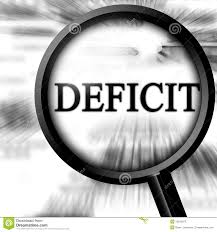A government budget comprises of expected revenue and expenditure during a fiscal year. There are two parts in a budget- Revenue budget and capital budget. A budget is said to be in surplus if the revenue is greater than the expenditure. But if the expenditure exceeds the revenue then there exists budget deficit. In simple words, a deficit occurs when the government spends more than it earns in the form of taxes and other sources. The excess expenditure is financed by either borrowing from capital markets or from the central bank.
There are different types of budget deficits depending upon the type of revenue and expenditure. The three forms of deficit are:
- Revenue deficit: Revenue deficit occurs when the total revenue expenditure exceeds total revenue receipts. The revenue receipts consists of tax revenue and non tax revenue like fees, fines etc. The revenue expenditure, on the other hand, means expenditure which doesn’t create any assets like salaries of employees, subsidies etc. Revenue deficit is an indication that the government is not able to meet its own expenditure from the revenue receipts. The revenue has to be met by borrowing. High Revenue deficit is considered dangerous as it implies a higher repayment debt. In order to avoid the deficit, a government should either curtail its expenditure or increase the taxes.
Revenue deficit =Total revenue expenditure –Total revenue receipts
- Fiscal deficit: Fiscal deficit refers to the excess of total expenditure over total receipts excluding borrowings during a fiscal year. It is the amount of borrowings that the government needs to meet its expenditure. A higher fiscal deficit implies a higher borrowings and hence, a higher payment obligation. It is recommended that fiscal deficit must be less than 5% of the GDP, otherwise as the borrowing increases, the government’s liability increase not only for the loan repayment but also for the interest payment. A high fiscal deficit may also lead to inflationary pressure.
Fiscal deficit =Total expenditure –Revenue receipts –Capital receipts(excluding borrowings)
- Primary deficit: Primary deficit refers to the excess of total expenditure over total receipts excluding borrowings and interest payments. In other words it is fiscal deficit minus interest payments. It tells how much the government needs to borrow to meet its current year’s expenditure. It doesn’t include the interest payments. If primary deficit is zero then, fiscal deficit is equal to interest payments on earlier loans. Therefore, it implies that the government has borrowed just to pay its interest.
Primary deficit =Fiscal deficit –Interest payments
Although the existence of primary deficit and revenue deficit are considered dangerous, a safe limit of fiscal deficit (within 5%) is a sign of growing economy. If the fiscal deficit occurs as a result of increased capital expenditure i.e. expenditure on building infrastructure or on fixed assets, then it is advantageous for the country.





22 Comments. Leave new
Nice
Good one..!
Great stuff!
Informative.
Beautifully written!
Well explained.. 🙂
Well written::)
Good work
well explained!
Well elaborated
informative article…
good work!
Well articulated.
good job!
Good efforts!Well explained!
Informative 😀
Intuitive and knowledgable
Nicely explained.
Nice work…very informative
informative
Well explained.
Made an interesting read!